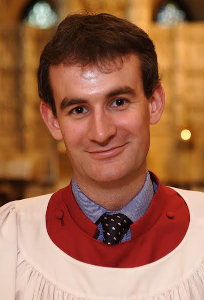Luke Bond (St George’s Chapel, Windsor Castle)

Paean: Herbert Howells
Scherzetto (3rd movement of Sonata in C minor): Percy Whitlock
Nimrod: Edward Elgar
Fantasia and Toccata in D minor: C V Stanford
Interval
Choral no. 1: César Franck
Sonata no. 1: Alexandre Guilmant
Luke Bond is the newly-appointed Assistant Director of Music of Saint George’s Chapel, Windsor Castle, having until recently been Assistant Director of Music at Truro Cathedral. His recital falls into two halves, the first of English music and the second of French.
We hear Howells, loud and fast for once in his Paean, one of the Six Pieces that he wrote in 1940 for his beloved Gloucester Cathedral, fearing that this building was doomed to destruction from the air and determined to commemorate its various moods.
Following the performance in September of the first movement of Whitlock’s Sonata, we hear the lighthearted Scherzetto, the third movement of this sonata, showing that even in a single work there were many sides to Whitlock’s character.
The nobility of Nimrod, ideally suited to the orchestral colours of the Binns organ, is followed by Stanford’s Fantasia and Toccata, a work redolent of nineteenth-century Germany, appropriate since in his formative years Stanford had studied in Leipzig and Berlin. And remember too that the great influence on J J Binns was the German organbuilder Edmund Schulze, which will ensure some authentic sounds at the Albert Hall.
But the Binns organ is no slouch where French music is concerned. Composed not long before Stanford’s piece is one of Franck’s last, the Choral no 1. In its first half this piece explores the soft stops of the organ, showing how colourful was the happy match of Franck and the organ-builder Cavaillé-Coll. The second half of the Choral shows Franck being loud and proud.
The recital ends with the first Sonata by the much-loved composer and teacher Alexandre Guilmant. This sonata began life as a symphony for organ and orchestra, and its solo organ version which we are to hear gives another opportunity to hear the orchestral colours of the Binns organ. Guilmant had studied in Brussels with Jacques Nicolas Lemmens (whose Parisian recitals, demonstrating his legato playing and expert pedal technique, were described by Cavaille-Coll as “the light”. And Guilmant demonstrates his own fluent pedal technique with the solo at the start of this Sonata which provides much of the thematic material for the movement; and midway there is the lovely second subject, proof that organists can write tunes. The slow movement is a lilting pastorale, with in the middle a more pious episode suggesting monks chanting. In contrast the finale is an absolute whirlwind. Sheer enjoyment throughout.
